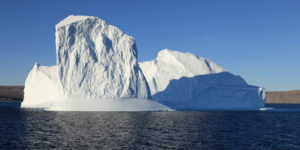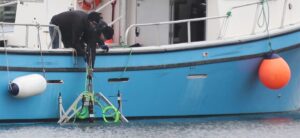Written by Rose Fisher
Winding, steep sided fjords peppered with islands comprise the Patagonia region in southern Chile. It’s a sparsely populated area, largely untouched by humans and industry. This nearly pristine environment has made the region a sanctuary for many marine mammals, in particular the secretive and endangered sei whale. Because of its untouched nature and rich biodiversity, it is a researchers dream however, its extreme isolation, which has allowed this protection, has also prevented its methodical inquiry. Now Patagonia Projects, led by Keri Pashuk and Greg Landreth, are bringing teams of researchers onboard their sailing vessel, Saoirse, to shine a scientific light on the region. Using icListen Smart Hydrophones outfitted with Teledyne Reson sensor tips, the team makes regular journeys down Chiles southern coast to collect acoustic data on the many species that call the area home.
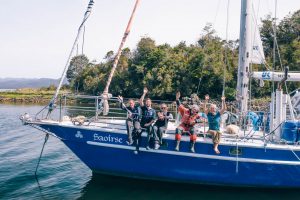
Keri and Greg are not researchers by trade, both could be characterized as adventurers. Keri is a photographer and Greg, a writer. Their journey to becoming facilitators of the Patagonia Projects research team began long ago when they began sailing to Antarctica to climb untrodden and difficult to reach mountains. Over the years, Keri and Greg began to notice the degradation of many of the places they visited, seeing trash accumulating in the oceans and changes in the environment. After witnessing so many troubling changes, they chose to re-invent their goals, pledging their vessel, Saoirse, as a platform for researchers to conduct query based environmental research. They named the venture Patagonia Projects.
In 2015, while on a benthic dive mission with Dr. Vreni Häussermann, Keri and Greg discovered a number of beached whale carcasses. Since making the initial discovery, many more dead whales have been found washed ashore between Golfo Penas and Puerto Natales, where Patagonia Projects has their home base. Through this grim discovery, Patagonia Projects began their current ongoing project, to create a snap shot of the area before outside threats from illegal fishing, unregulated aquaculture and climate change, alter the area forever.
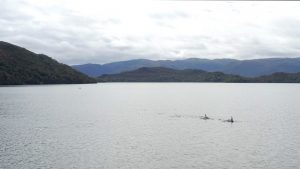
Patagonia Projects invite researchers with different specialized skills and areas of research onboard Saoirse. The crew changes with researchers schedules however, they have found that acoustic recordings, combined with visual observations are proving to be the most effective tools to illuminate what cannot be seen in the depths of these remote channels. Patagonia Projects use an icListen Smart Hydrophone outfitted with a Teledyne Reson sensor tip (RB9) to collect acoustic data. In 2018 the team began using novel deployment methods to collect baseline data on the region.
The researchers knew they wanted to collect sound data in two ways; opportunistically through strategic short term deployments when sei whales are actually sighted, to match the sounds with the individual animals, and also to collect long term soundscape recordings. To collect opportunistic data, Keri, Greg and team used visual identification to determine if there were marine mammals in the area. They then would launch an icListen on a float with an Ocean Sonics Launch Box which provides a wifi link, making real-time monitoring possible. Then, with the engine and a sonar equipment turned off they could manoeuvre the vessel silently away from the hydrophone. Through this new deployment method, the crew were able to make recordings of the animals without interfering with them, especially if the animals were feeding. Their drone recorded video simultaneously to make identification of the recorded animals easier.
Before the team set sail for home in December 2018, they deployed their long term recording system. The system consisted of an icListen RB9 digital hydrophone with internal logging capabilities and Teledyne Reson omnidirectional sensor tip, connected to an Ocean Sonics battery pack. The battery pack is embedded in a secure mooring with the hydrophone attached directly to the top. The team installed the recorder at the mouth of a small gulf, visited often by marine wildlife. As this area has not been explored, and few acoustic recordings have been collected, the researchers hoped that when they returned in three months time, they would find a wealth of recordings.
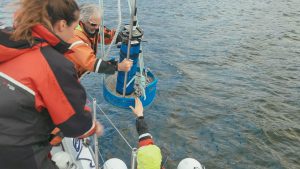
The long term acoustic recorder was deployed mid-December of 2018, the team returned to collect the recorder in March. The data stored in the hydrophone revealed a number of discoveries for the Patagonia Projects team. Many vocalizing Sei whales can be heard throughout the data set, proving that the area is a key feeding ground for the endangered whales to visit. They estimate that they may have increased the record of verifiable sei whale calls by a very large margin. The team is still combing through the data to identify other marine mammals in the recordings.
The ultimate goal of these expeditions is to assist in identifying and securing marine protected areas in the Patagonia region. Capturing baseline data is the first, and most critical step in the process. Patagonia Projects are using the data collected from their icListen hydrophones to demonstrate the need to establish protected areas and ensure the safety and longevity of this rich environment.
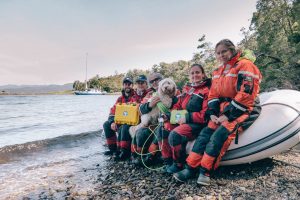
The relationship between Ocean Sonics and Teledyne Reson began in 2010. Ocean Sonics had launched their 3rd generation smart hydrophones and needed reliable acoustic sensors with which to perform calibrations. This task was only trusted to the Teledyne Reson TC4034 acoustic sensor. Ocean Sonics enjoyed using the Teledyne Reson sensor so much, they chose to digitize it, becoming the digital solution for Teledyne Reson hydrophones. In 2015 Ocean Sonics launched their RB9 model smart hydrophone, a completely digitized hydrophone with a custom-made Reson sensor, TC4059. Through this Teledyne Reson sensor, Ocean Sonics was able to achieve low drift, low self-noise, reliable smart hydrophones with 900m depth rating. The collaboration between the two companies has been fruitful, pushing the bounds of underwater acoustic innovation. As Ocean Sonics launches their next generation Smart Hydrophones, beginning with the icListen Kayak, they trust Teledyne Reson to provide top quality acoustic sensors, ensuring simplicity, accuracy and reliability for users.
*Click Here to read the use case on the Teledyne company blog
**Photos provided by Keri Pashuk and Greg Landreth of Patagonia Projects
